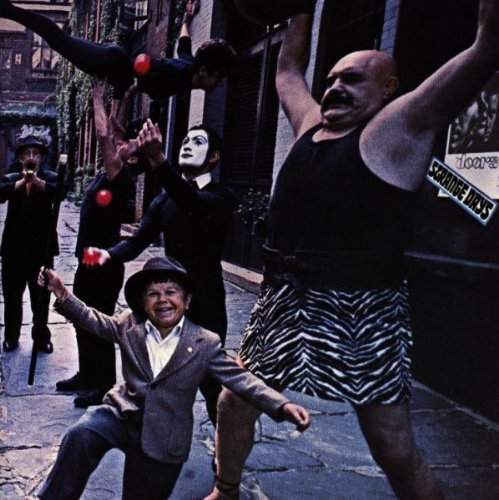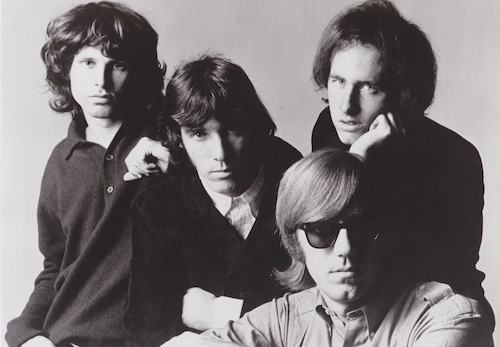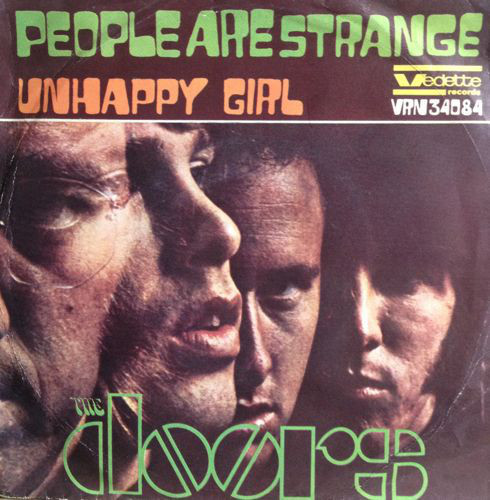
The year 2017 was a big one for 50th anniversaries: June alone marked a half-century since the release of Sgt. Pepper, and the first major rock festival, Monterey Pop. That year also gave us debut albums from the Jimi Hendrix Experience, Pink Floyd, the Grateful Dead, the Velvet Underground and The Doors, whose self-titled shocker of an intro was released only days into the new year, January 4, 1967, on Elektra Records.
The Doors was like nothing that had come before. Most of the attention, from the start—aside from his raw, bad-boy sex appeal—was focused on the sophistication and visual power of Jim Morrison’s poetic lyrics. The showpiece was the harrowing and raw, nearly 12-minute “The End”: Was there ever a more chilling passage in a rock song than the one that begins with “The killer awoke before dawn, he put his boots on/He took a face from the ancient gallery and he walked on down the hall” and ends in a blurred, nightmarish vision of patricide and incest?
The ballad “The Crystal Ship,” meanwhile, was shimmering in its vivid imagery (“Oh tell me where your freedom lies/the streets are fields that never die/Deliver me from reasons why/you’d rather cry, I’d rather fly”); “Soul Kitchen” and “Twentieth Century Fox” were both sly and funky; the sing-songy cover of Brecht and Weill’s “Alabama Song” was irresistible and even the lesser known tracks like “Take It as It Comes” and “I Looked at You” heralded the arrival of a visionary new group.
The Doors’ debut also, of course, gave us “Light My Fire,” and while—like all of the Doors’ material—its composition was credited to the entire group, the band’s maiden hit—which rose, in an edited version, to the top of the Billboard singles chart in July ’67—was penned by Robby Krieger, the band’s guitarist (except for the second verse, which is Morrison’s). Krieger, keyboardist Ray Manzarek (who supplied most of the Doors’ bass lines on his organ, when they didn’t call in freelancers to play an actual bass guitar) and drummer John Densmore were not so much support musicians for their flamboyant and charismatic frontman as equal contributors—without any of them, the Doors simply would not have been the Doors.
The success of “Light My Fire,” both on AM Top 40 radio and in the emerging world of underground FM rock radio, meant that the Doors would have to quickly release a followup to keep the momentum going. As they became more successful, moving from the homegrown clubs of L.A.’s Sunset Strip to the San Francisco hippie ballrooms and, soon enough, colleges and theaters, they needed more material. Even as The Doors was riding high, the quartet was at work preparing its sophomore release.

The album, which they called Strange Days, was released only eight months after the first, on Sept. 25, 1967. Where the debut was cut in less than a week, the Hollywood sessions for the followup were stretched over a period of months, allowing the band to fine-tune its new material and to make use of Sunset Sound Recorders’ brand new eight-track recording equipment, and the unconventional instruments they discovered. Producer Paul Rothchild and engineer Bruce Botnick took a greater role in the creative process this time around, introducing the group members to exciting ways of enhancing the raw tracks with the technology at their disposal.
Related: Our look back at 1967’s year in music
That sat perfectly well with the Doors, who were all about diving headlong into the unknown. On the album’s title track, “Strange Days,” On the title track, Morrison plays the Moog synthesizer—one of the first rock recordings to use one. (A fan reports: “His microphone was plugged into the synthesizer, and he pressed a key with each syllable he sang, giving his voice that eerie sound.”) Manzarek plays the organ on the track.
“Horse Latitudes,” meanwhile, was a Morrison poem married to a minute and a half of found sounds manipulated in the studio to eerie and foreboding effect.
Most of the song material on Strange Days was already in existence in one state or another by the time the Doors hit the studio—“Moonlight Drive” was, in fact, the first set of lyrics Morrison presented to Manzarek, enough to convince the keyboardist they had the makings of a great band. On the album, Morrison’s words are accompanied by Krieger’s bottleneck guitar and a compelling rhythm that’s at turns swinging and snappy on the verses and considerably more forceful on the choruses, courtesy of Densmore and Manzarek.
Strange Days, which itself landed at #3, one point behind the debut, yielded two hit singles, “People Are Strange” and “Love Me Two Times.” Neither came close to repeating the #1 success of “Light My Fire,” reaching #12 and 25, respectively, but they still became permanent members of the classic rock airplay club, getting countless spins on what’s left of rock radio (and on rock internet stations) even today. Even its surreal album cover, New York street performers photographed by Joel Brodsky, has become emblematic of its heady era, a recognizable relic of a certain time when anything, the odder the better, was not only possible but encouraged.
As was often the case on the Doors’ albums, some of the tunes that got the least attention by radio programmers were among the most innovative and absorbing. Here, so-called filler songs like “You’re Lost Little Girl,” “Unhappy Girl,” “I Can’t See Your Face in My Mind” and “My Eyes Have Seen You” featured some of Morrison’s and the instrumentalists’ most inspired performances of that busy year, and they still hold up today.
But, as was the case on album number one, it was the grand finale of Strange Days, “When the Music’s Over,” that rightfully received the most concerted attention. At 11 minutes it was just slightly shorter than “The End,” and while it lacked the lyrical shock value of its predecessor, its tale, and the delivery of it, was epic in its own right. Over a brooding, meandering, often exotic melody that alternately sprawled and intensified, Morrison asked us repeatedly to “turn out the lights” when the music was over. As he unfurled his hypnotic dream-state of a lyric, Krieger, Manzarek and Densmore improvised and explored, creating a drama that accelerates incrementally.

Morrison works himself into a trance state. Early on he instructs us:
“Cancel my subscription to the Resurrection
Send my credentials to the House of Detention
I got some friends inside.”
His story line is opaque, never linear; there are warnings and wishes and there is joy. There is much mystery.
“What have they done to the earth?
What have they done to our fair sister?
Ravaged and plundered and ripped her and bit her
Stuck her with knives in the side of the dawn
And tied her with fences and dragged her down”
Densmore’s sticks fly in random direction. The bass whispers.
“I hear a very gentle sound
With your ear down to the ground
We want the world and we want it…
We want the world and we want it…
Now
Now?
Now!”
That’s it. An explosion ensues. We experience Morrison as we’ve never heard him before: uncoiled, possessed, demonic, frightening. “Save us!” he cries. “Jesus! Save us.”
“When the Music’s Over” still leaves the listener breathless. We’re reminded that the music is our “special friend,” our “only friend.” But will it save us? “Until the end. Until the end. Until the…ennnnd.” It’s rock theater at its most histrionic. We’re drained. Like so much that year, the Doors have taught us that our music knows no bounds.
Jim Morrison and the Doors would only last four more years, but from these first two offerings, both made within the same glorious year, they had us…until the end.
Watch the Doors’ video for “People Are Strange”
[easy_sign_up title=”Sign up for the Best Classic Bands Newsletter”]
- Over Under Sideways Down: Making Sense of the Yardbirds’ Album Releases - 05/27/2024
- 17 Classic Chuck Berry Covers - 05/18/2024
- ‘Brandy’ by Looking Glass (It’s a Fine Song) - 05/18/2024


10 Comments
I have a penchant for liking bands who have their own distinct sound, but not every song sounding the same. The Doors definitely fall into this category. No one else sounds like the Doors, and you can generally tell one of their songs within a few notes.
I purchased STRANGE DAYS upon its release in 1967, and it’s still my favorite album today among the two thousand that I own! On the title track, it’s actually Jim Morrison playing the Moog synthesizer. (Ray Manzarek plays the organ.) Jim’s microphone was plugged into the synthesizer, and he pressed a key with each syllable he sang, giving his voice that eerie sound.
Thanks for that fascinating info. We’ll make the correction in the article.
Thanks Jeff. I’ve been reading you since the early Goldmine days, and this Doors article is as good as anything before it. Incredible LP and wonderful article. You have the litterrary nuance that makes it so fun to read. I got to meet Krieger after the show last year at City Winery. He was so nice and still ROCKS! Thanks again. –Keith Vyse, NYC
Thank you so much! Glad you enjoyed the piece. I’ve loved the Doors since I first heard “Light My Fire.”
There was no one like The Doors, The End would have to be one of the most chilling songs of the late 60’s & the lyrics also When The Music’s Over are so haunting & foreboding both legendary
I have and always loved The Doors for 25 years and counting. They are a one of a kind band that nobody can ever copy ! Rock on Doors ♥️
Back in 1968 and junior year in high school, one of my friends used to sneak into empty classrooms, grab a piece of chalk, write the lyrics to “Horse Latitudes” on the blackboard, and then beat it out of there, leaving a little something for the next group of eleventh-graders to ponder over before teacher erased it all.
I don’t know about anyone else, but as the decades pass on for me, I often feel suddenly able to hear songs I’d long had memorized in my mind, with new ears. There’s some music you’re able to unfathomably listen “into” more, while with others, it’s like a sheen of your expectation about what the song has been (almost like a still painting in your mind) can sometimes fall away, and you’re just able to “hear” it anew. I’ve experienced this sensation frequently with the Doors music of late. And I guess because, as you say in your article, Jeff, our initial exposure to the Doors’ music was so easily fixated on Morrison that the individual musical components of The Doors’ music are, perhaps subconsciously, integrated into static paintings in one’s mind, as unusual and innovative as it was collectively. But in recent listenings, I’ve become more able to take their music apart and appreciate what each member brought to these songs, and, consequently, to The Doors’ sound as a whole. When you think about it, it really was strange that Ray fixated on using a tabletop organ in so much of their music, which was already kind of an antiquated sound in rock music by that time, as most were plumbing the depths of the incredible Hammond B3 and Leslie speakers. Also, during a period that yielded so many what we now consider the greatest rock guitarists of all time, Robby approached music with completely different styles, sounds, tones, and licks than almost anyone else. He was probably one of the first rock guitarist to incorporate slide guitar into “parts” of songs, rather than as just a lead instrument. At the time, I think Krieger’s seemingly more orchestral, or non-direct approach, to applying guitar parts to songs often left him unheralded as a instrumentalist, which is true of many others with a similar approach, such as Justin Heyward for one example. John Densmore’s jazz style was certainly a different kind of drummer than almost all the more famous drummers who were making rock records back in their day. Yet, like the individually distinct sounds his Doors brethren, his spot-on percussive contributions to each of their recordings were perfect, and made the Doors’ music so distinctly their own, unlike anything before them, or anyone else since. As you say, Jeff, these other three Doors members were so much more than backing musicians for the utterly unique and talented Morrison. Together, their remarkable musical alchemy created six musical masterpieces that each stand on their own with unique sonic personalities and mind visions. If you can, forget what you know, when you next hear a Doors song or record, and listen in….. .
Wasn’t “You’re Lost Little Girl” the song that Paul Rothchild hired some extra “help” for Morrison to get in the mood? Whereupon Pam said the equivalent of “Hold my beer. I’ve got this.”